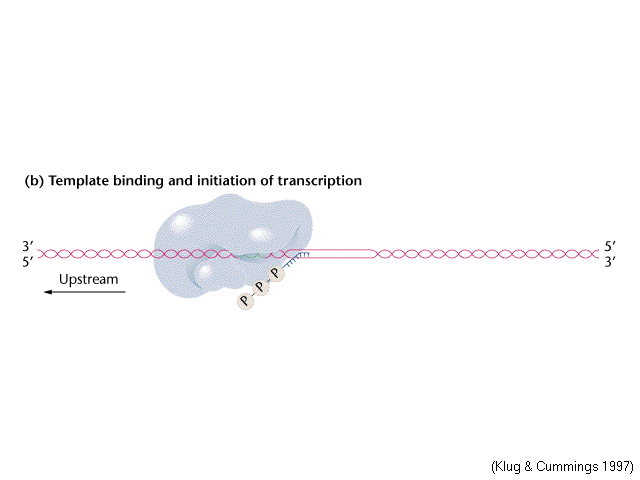|
How important transcription is
With the help of electron microscopy and a relatively new technique called single particle image analysis,
the researchers reconstructed a three-dimensional picture of the heart of the machine -- the part that binds to DNA.
The picture shows for the first time how the proteins are arranged, and gives clues to the inner workings of the machinery
that transcribes genes the complex of proteins that latches onto and copies DNA into an RNA blueprint for building proteins.
"For now, this is very basic, very fundamental research that helps us understand how the machine works," said team leader
Eva Nogales, an assistant professor of molecular and cell biology at UC Berkeley and a scientist at LBNL.
"But it has implications for the treatment of disease, since essentially treatment comes down to modifying the behavior of proteins. One way to do that is to regulate transcription, which is why this machine is a major target for drug development."
|
|
Initiation , elongation & Termination
Initiation,Elongation & Termination
The Core enzyme begins transcription at initiation site. Chain elongation proceeds by addition of ribonucleotides at 3' end . RNA synthesized 5'3' template DNA strand is 'read' 3'5' so, RNA is homologous to partner DNA strand no primer required.The rho () subunit of RNA polymerase recognizes termination site and the rna produced thus is cleaved. The RNA produced here is the m-RNA (messenger RNA) and it requires the coordinated effort of t-RNA or the transfer RNA(which helps in bringing the amino acids from the cytoplasm) for protein synthesis
click here for more
Eukaryotic transcription differs
One of the features of prokariotic RNA, is its very short life (minutes). In contrast, more stable mRNAs are found in eukaryotes. For example, the mRNA for haemoglobin in the red cell, is active for hours and even days, after the loss of the nucleus.
RNA is stable after a few modification steps.
Capping: most mRNAs have their starting end blocked by the addition of a cap (7-methylguanosine). The cap structure has no free phosphates, and then is protected from attack by phosphatases, or nucleases
Addition of a poly-A tail : this polyadenylic segment is 100 to 200 nucleotides long and is added sequentially after transcription is completed by the action of a poly A synthetase that uses ATP as substrate.
Methylation: when a methyl group is added to nucleotides.
Cleavage of big RNAs: when the polymerase arrives at the end of the RNA, it does not terminate transcription abruptly, but goes on transcribing DNA (sometimes 1500 nucleotides). The transcript is cut and polyadenylated while it is still transcribed.
Splicing: eukaryotic genes are frequently interrupted by intervening sequences (introns). These sequences must be removed and the molecule precisely rejoined in the correct sequence, because an error of one nucleotide would cause the rest of the message to be read incorrectly.
click here for more info
|
 initiation,elongation
initiation,elongation
|


